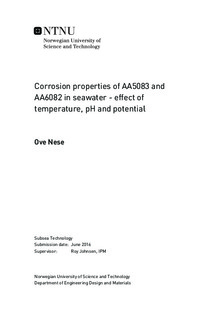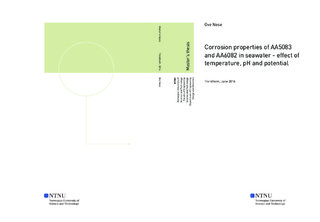| dc.description.abstract | Aluminium is an interesting material for use in subsea structures due to its low weight. So called corrosion resistant aluminium alloys from the Al-Mg (5xxx)- and Al-Mg-Si (6xxx) series have been used for many years in ship hulls, and the experiences are good. However, corrosion failures have been observed. Used for subsea structures, aluminium will in most cases be in metallic contact with carbon steel or more noble metals, hence galvanic corrosion becomes a threat. Carbon steel is always connected to a cathodic protection (CP) system in seawater, this means that the aluminium alloy also will be connected to the CP.
In this study the aluminium alloys accepted in NORSOK for use subsea, AA5083 and AA6082, have been investigated. AA5083 and AA6082 were tested in natural seawater with temperature of 10 ± 2 ᵒC and 32 ± 2 ᵒC, and in synthetic seawater (SSW) with adjusted pH at room temperature. The adjusted pH was 3 and 10. Samples were freely exposed, anodic polarized to −700 mV vs Ag/AgCl, cathodic polarized to −1500 mV vs Ag/AgCl and coupled to a sacrificial anode. Recording of potentiodynamic polarization curves, open circuit potentials (OCP) and current demand was performed during exposure. Surface examination in a scanning electron microscope (SEM) was also performed.
The results from this study indicate that the temperature affects the corrosion behavior for both AA5083 and AA6082. Increased temperature increases the severity and rate of corrosion, the overall effect of temperature tended to be the same for both alloys. The electrochemical potential had a significant effect on the corrosion behavior. Freely exposed samples and samples coupled to sacrificial anodes exhibits good resistance to corrosion in seawater, both at 10 ᵒC and 32 ᵒC. Anodic polarization to −700 mV vs Ag/AgCl and cathodic polarization to −1500 mV vs Ag/AgCl will cause severe corrosion on AA5083 and AA6082. Different pH also affects the corrosion behavior of AA5083 and AA6082. Both alloys are sensitive to changes in pH, but the results in this study indicate that AA6082 tended to be less sensitive to low pH than AA5083. The experimental potential pH diagram for AA5086, Figure 3, is a good guideline for AA5083 and AA6082 at seawater conditions (pH 8,2). The diagram can also be used as a rough guideline for AA5083 and AA6082 at pH 3, but the results showed that it is not valid for AA5083 and AA6082 at pH 10. After 800 hours of exposure the required cathodic current density for CP in nearly stagnant natural seawater at 10 ᵒC for AA5083 and AA6082 were −1,8 and −2,3 μA/cm2, respectively. Required cathodic current density for CP in nearly stagnant natural seawater at 32 ᵒC for AA5083 and AA6082 were −0,75 and −1,7 μA/cm2, respectively. | |

